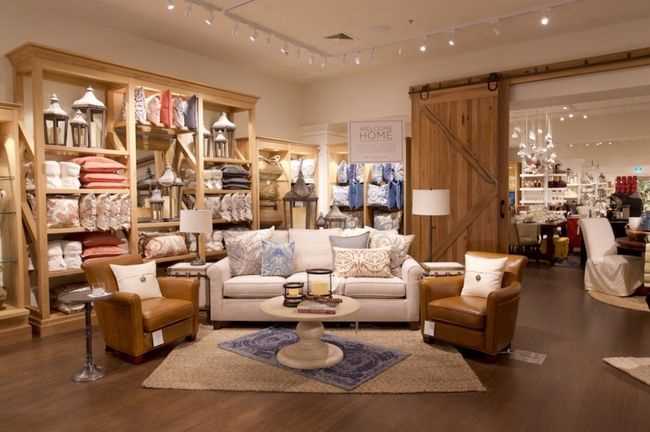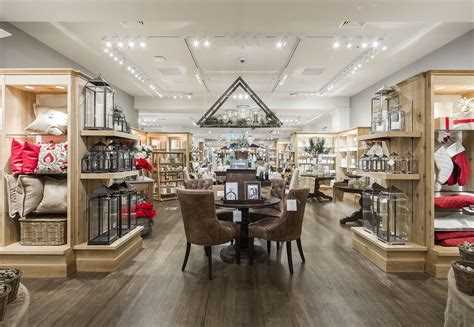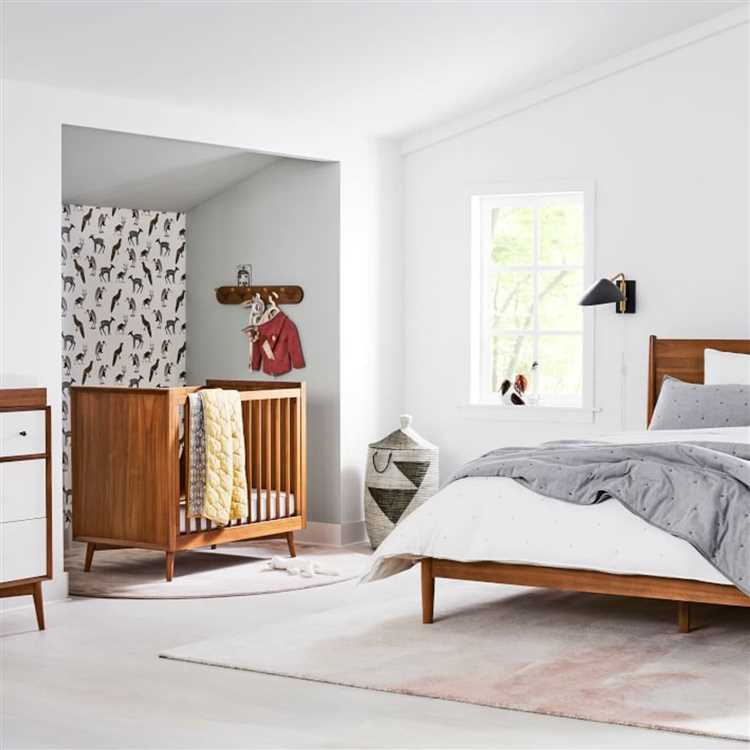In the world of furniture and home decor, certain brands have made a name for themselves with their unique designs and high-quality products. Two such brands that often come up in conversations are West Elm and Pottery Barn. While these brands have distinct identities and styles, there has been speculation about their relationship. Many wonder if West Elm is owned by Pottery Barn and if there is a connection between the two.
West Elm and Pottery Barn are both well-known names in the industry, offering a wide range of furniture, accessories, and home decor items. They each have their own aesthetic and target audience, with West Elm often associated with modern and contemporary designs, and Pottery Barn known for its classic and traditional styles.
Despite their differences, there is indeed a connection between West Elm and Pottery Barn. The two brands are both part of the Williams-Sonoma family of brands, which is a renowned name in the home furnishings industry. Williams-Sonoma, Inc. is a major retailer that owns several other popular brands in addition to West Elm and Pottery Barn, including Williams Sonoma Home, Williams Sonoma, and Pottery Barn Kids.
While West Elm and Pottery Barn are part of the same corporate family, they operate independently and have their own dedicated teams responsible for design, production, and customer service. Although there may be some shared resources and collaborations between the two brands, such as cross-promotions or joint marketing efforts, they maintain their distinct identities and continue to offer their unique products to their respective customer bases.
Exploring the Connection Between West Elm and Pottery Barn
When it comes to furniture brands, West Elm and Pottery Barn are often mentioned together. Many people wonder if there is a connection between these two popular companies. Let’s explore the relationship between West Elm and Pottery Barn to better understand their connection.
West Elm and Pottery Barn are both furniture brands that are owned by Williams-Sonoma Inc., a renowned American retailer of high-quality home products. Williams-Sonoma Inc. operates several other well-known brands in addition to these two, including Pottery Barn Kids, Pottery Barn Teen, and Williams Sonoma Home.
While West Elm and Pottery Barn are sister brands under the same corporate umbrella, they do have some distinct differences in terms of their target markets and design aesthetics.
Pottery Barn has been around since 1949 and is known for its classic, timeless designs that often have a rustic or traditional feel. The brand offers a wide range of furniture and home decor items that are popular among homeowners looking for traditional, elegant pieces.
On the other hand, West Elm was founded much later in 2002 and aims to cater to a younger, more modern audience. The brand is known for its contemporary and mid-century modern designs, often incorporating bold colors and unique patterns. West Elm appeals to those who are looking for trendy, stylish pieces that can elevate their living spaces.
Despite their differences, West Elm and Pottery Barn do occasionally collaborate on certain collections or products. This cross-pollination of styles allows customers to enjoy the best of both brands, blending the timeless elegance of Pottery Barn with the modern flair of West Elm.
Both West Elm and Pottery Barn have a strong online presence, making it easy for customers to browse and purchase their products. Additionally, they have numerous brick-and-mortar stores across the United States, where customers can see and touch the furniture before making a purchase.
In conclusion, West Elm and Pottery Barn are connected as sister brands under the same parent company, Williams-Sonoma Inc. While they have their own distinct identities and target markets, they occasionally collaborate to offer customers a blend of traditional and modern design aesthetics. Whether you prefer the timeless elegance of Pottery Barn or the contemporary vibes of West Elm, both brands provide high-quality furniture and home decor options for all tastes.
Understanding the Ownership Structure
When exploring the connection between West Elm and Pottery Barn, it is important to understand the ownership structure of these two furniture brands. While both brands operate under the Williams-Sonoma Inc. umbrella, there are distinct differences in their ownership and management.
West Elm:
West Elm is a brand that falls under the Williams-Sonoma Inc. portfolio. It was founded in 2002 as a subsidiary of Williams-Sonoma Inc. Since its inception, West Elm has positioned itself as a modern and affordable furniture brand targeting young professionals and urban dwellers. With its focus on contemporary designs and sustainability, West Elm has gained popularity among customers seeking stylish and eco-friendly furniture options.
Pottery Barn:
Pottery Barn, on the other hand, is also a brand under Williams-Sonoma Inc., but it has a longer history compared to West Elm. Pottery Barn was founded in 1949 and initially specialized in selling housewares and home furnishings with a rustic and traditional aesthetic. Over the years, Pottery Barn has expanded its product offerings to include a wider range of furniture and decor items, catering to a broader base of customers.
Ownership Relationship:
While both West Elm and Pottery Barn are owned by Williams-Sonoma Inc., the two brands operate independently with their separate design teams, product offerings, and marketing strategies. Each brand focuses on its own target market and maintains its unique identity. However, being under the same ownership allows for potential collaborations, cross-promotions, and shared resources between the two brands.
Benefits of the Ownership Structure:
The ownership structure of West Elm and Pottery Barn under Williams-Sonoma Inc. provides several benefits. Firstly, it allows for economies of scale in terms of sourcing materials, manufacturing, and logistics. Both brands can leverage the purchasing power of the larger company to negotiate better deals with suppliers and streamline their operations.
Secondly, the ownership structure enables knowledge sharing and collaboration between the design teams of West Elm and Pottery Barn. Sharing expertise, insights, and resources can result in product innovations and improved customer experiences for both brands.
Lastly, the ownership structure allows for cross-promotions and synergies between West Elm and Pottery Barn. By leveraging their respective customer bases, the brands can introduce their customers to each other’s products and potentially increase sales.
In conclusion, while West Elm and Pottery Barn are both furniture brands owned by Williams-Sonoma Inc., they operate independently with their separate identities and strategies. The ownership structure provides benefits such as economies of scale, knowledge sharing, and cross-promotions between the two brands.
Comparing the Brand Identities
West Elm:
West Elm is a modern furniture and home decor brand that focuses on providing stylish and sustainable products. The brand is known for its contemporary designs and commitment to environmentally friendly practices. West Elm offers a wide range of furniture pieces, decor items, and textiles that are designed to bring a fresh and fashionable look to any space.
One of the key aspects of West Elm’s brand identity is its emphasis on ethical sourcing and sustainability. The company strives to use eco-friendly materials and production methods, and it actively supports fair trade practices. West Elm also partners with various organizations to create socially responsible products and initiatives.
In terms of style, West Elm’s designs are characterized by clean lines, minimalist aesthetics, and a balanced mix of classic and contemporary elements. The brand aims to create timeless pieces that can easily blend with different interior styles.
Pottery Barn:
Pottery Barn is a classic furniture and home decor brand that focuses on creating comfortable and stylish living spaces. The brand is known for its timeless designs, high-quality craftsmanship, and attention to detail. Pottery Barn offers a wide range of furniture, decor, and accessories that cater to various styles and preferences.
One of the defining features of Pottery Barn’s brand identity is its emphasis on creating warm and inviting spaces. The brand aims to bring a sense of comfort and coziness to homes through its curated collection of products. Pottery Barn also offers personalized services, such as design consultations, to help customers create their dream spaces.
In terms of style, Pottery Barn’s designs are characterized by a mix of classic and rustic elements. The brand incorporates traditional designs with modern touches, creating a timeless yet relaxed aesthetic. Pottery Barn’s products are often made from high-quality materials and feature intricate details that add charm and character to any space.
Comparison:
While both West Elm and Pottery Barn are furniture and home decor brands owned by the same parent company, they have distinct brand identities that cater to different audiences and design preferences.
- West Elm focuses on modern and contemporary designs, while Pottery Barn leans towards classic and timeless styles.
- West Elm prioritizes sustainability and fair trade practices, while Pottery Barn emphasizes comfort and personalized services.
- West Elm’s designs are characterized by clean lines and minimalist aesthetics, while Pottery Barn incorporates more traditional and rustic elements.
Overall, both West Elm and Pottery Barn offer quality products that cater to different design sensibilities. Whether you prefer a modern and eco-friendly look or a classic and cozy feel, there is a brand within the family to suit your style and needs.
Product Offering and Price Ranges
Both West Elm and Pottery Barn offer a wide range of furniture and home decor products to cater to different preferences and budgets. However, there are some differences in their product offerings and price ranges.
West Elm:
- West Elm primarily focuses on modern and contemporary designs, with clean lines and minimalist aesthetics.
- The brand offers a diverse range of furniture, including sofas, chairs, tables, beds, and storage units.
- In addition to furniture, West Elm also offers home decor items such as rugs, lighting fixtures, bedding, and wall art.
- The price range for West Elm products tends to be more affordable compared to Pottery Barn, targeting young adults and individuals with a more limited budget.
Pottery Barn:
- Pottery Barn offers a more traditional and classic design aesthetic, with a focus on rustic and vintage-inspired furniture and decor.
- The brand offers a wide range of furniture for various rooms in the house, including living room, bedroom, dining room, and outdoor spaces.
- Pottery Barn also offers home decor items, including bedding, curtains, rugs, lighting, and wall art.
- The price range for Pottery Barn products is typically higher compared to West Elm, positioning itself as a more upscale brand targeting customers who are willing to invest in higher-quality and more expensive pieces.
Overall, while both West Elm and Pottery Barn offer a similar range of furniture and home decor products, they cater to different design preferences and price points. West Elm focuses on modern and affordable designs, while Pottery Barn offers more traditional and higher-end options.
Physical and Online Presence
Both West Elm and Pottery Barn have a strong physical and online presence, allowing customers to shop in-person and online.
Physical Stores:
- West Elm operates standalone stores across the United States, Canada, Australia, and the United Kingdom. These stores provide customers with a hands-on experience, allowing them to see and touch the furniture before making a purchase.
- Pottery Barn also has a significant number of physical stores across the United States, Canada, Australia, and the United Kingdom. Their stores showcase a wide range of home furnishings and decor.
- In some cases, West Elm and Pottery Barn have co-located stores, meaning that they share the same physical space. This allows customers to easily shop between both brands and find complementary products.
Online Presence:
- Both West Elm and Pottery Barn have well-established e-commerce platforms, offering customers the convenience of shopping from the comfort of their own homes.
- West Elm’s website features an extensive catalog of furniture, bedding, rugs, and decor items. Customers can easily browse and purchase products online.
- Pottery Barn’s website offers a similar online shopping experience, with a wide array of products available for purchase.
Collaborations and Partnerships:
- Both brands have collaborated with renowned designers and influencers to create unique and exclusive collections. These collaborations help to expand their customer reach and offer fresh and innovative designs.
- West Elm has collaborated with designers such as Roar + Rabbit, Leanne Ford, and Sarah Sherman Samuel.
- Pottery Barn has partnered with designers like Emily & Meritt, Monique Lhuillier, and Shay Mitchell.
In conclusion, West Elm and Pottery Barn have a strong presence both offline and online, with physical stores allowing customers to experience the products firsthand and online platforms providing convenience and accessibility. Their collaborations and partnerships further enhance their offerings and cater to a diverse range of customers.
Cross-Promotions and Collaborations
West Elm and Pottery Barn, as sister brands, often engage in cross-promotions and collaborations to leverage their combined customer base and enhance brand visibility. Through these initiatives, the brands utilize their respective resources, expertise, and aesthetics to create unique and compelling offerings for their customers.
One prominent example of cross-promotion between West Elm and Pottery Barn is their joint marketing campaigns. They frequently feature each other’s products in their respective catalogs, websites, and social media platforms. By doing so, they introduce their customers to the other brand, encouraging cross-shopping and increased sales.
In addition to joint marketing, West Elm and Pottery Barn have collaborated on product collections. These collaborations bring together the distinct design sensibilities of both brands to create unique furniture and home decor items. For example, they might combine West Elm’s modern and eclectic style with Pottery Barn’s traditional and timeless aesthetic, resulting in products that appeal to a wider range of customers.
Another form of collaboration is the co-creation of exclusive collections with external designers and artists. West Elm and Pottery Barn often partner with renowned designers to develop limited edition collections that highlight their individual styles and expertise. These collaborations not only attract new customers but also showcase the brands’ commitment to craftsmanship and design innovation.
Furthermore, the brands frequently offer joint promotions and discounts to incentivize customers to shop across both West Elm and Pottery Barn. For example, they might offer a discount on West Elm products for customers who purchase a certain amount from Pottery Barn, or vice versa. These promotions encourage customers to explore both brands’ offerings and create a mutually beneficial relationship between West Elm and Pottery Barn.
Overall, cross-promotions and collaborations play a significant role in the connection between West Elm and Pottery Barn. By leveraging their shared resources and design sensibilities, the brands are able to create unique and compelling offerings for their customers, while also strengthening their market position and driving increased sales.
Customer Reviews and Perception
Customer reviews play a crucial role in shaping the perception of a brand and its products. The same holds true for West Elm and Pottery Barn, two prominent furniture brands that have a connection.
When it comes to customer reviews, both West Elm and Pottery Barn have received a mix of positive and negative feedback. Some customers express satisfaction with the quality and design of the furniture, praising the brands for their style and durability. These positive reviews often highlight the attention to detail, the use of high-quality materials, and the overall aesthetic appeal of the products.
On the other hand, there are also negative reviews that address issues such as delivery delays, customer service problems, and perceived lack of product reliability. Some customers have reported difficulties with returns or exchanges, leading to frustration and disappointment.
However, it’s important to note that individual experiences can vary, and customer reviews represent a subjective perspective. What may be a negative experience for one customer could be a positive one for another.
Overall, both brands have cultivated a reputation for offering stylish and contemporary furniture options. West Elm is known for its modern designs and sustainable practices, while Pottery Barn is renowned for its classic and timeless aesthetic.
Understanding the customer reviews and perception of these brands can help potential buyers make informed decisions about their furniture purchases. It’s advisable to read a variety of reviews and consider factors such as personal preferences, budget, and specific product needs.
In conclusion, customer reviews provide valuable insights into the strengths and weaknesses of West Elm and Pottery Barn, helping customers make well-informed choices based on their individual preferences and needs.
FAQ:
Is West Elm owned by Pottery Barn?
Yes, West Elm is owned by Pottery Barn. Pottery Barn, a furniture and home decor retailer, acquired West Elm in 1986.
What is the connection between West Elm and Pottery Barn?
West Elm and Pottery Barn are both furniture brands. Pottery Barn acquired West Elm in 1986 and they have been operating as sister companies since then.
When did Pottery Barn acquire West Elm?
Pottery Barn acquired West Elm in 1986.
Are West Elm and Pottery Barn owned by the same company?
Yes, both West Elm and Pottery Barn are owned by the same company. Pottery Barn acquired West Elm in 1986 and they have been operating under the same ownership since then.
Why did Pottery Barn acquire West Elm?
Pottery Barn acquired West Elm in 1986 as a strategic move to expand its furniture offerings. West Elm brought a modern and contemporary aesthetic to the company’s portfolio, complementing Pottery Barn’s traditional style.


